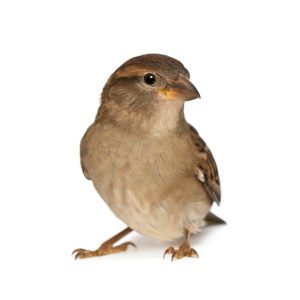House Sparrow
Although a beautiful, small bird, house sparrows can cause considerable damage to your facilities, food products and animal feed.
Nesting Habits
House sparrows nest in protected areas in, on, or near buildings, such as building ledges, gutters, signs, light fixtures, and under eaves and bridges. They will also nest inside warehouses, airport buildings, stores and stadium roofs. House sparrows will displace other birds from their nests and destroy any eggs so the nest can be used to rear their own. When they build nests, both male and female sparrows use grass, straw, feathers and other debris to construct a large and flimsy nest. Sparrows will use the same nesting sites over and over.
House sparrows are very territorial, both as individuals and as flocks. They restrict their nesting and feeding sites to specific locations. They will congregate in urban areas in winter months, but will usually return to rural areas in the spring.
Damage
House sparrows can cause considerable damage to crops, such as wheat and sorghum. They can contaminate animal feed and food products, and their droppings are of medical concern because they are associated with more than 29 diseases and ectoparasites (e.g., bird mites). The presence of house sparrows indoors represents a food safety risk and an unsanitary condition, and their droppings can cause damage to buildings.

Common Characteristics
Males are brownish streaked with black on their wings and back, females are dusky/dirty brownish gray with faint blackish stripes on wings and back.
About six inches (14.6-15.9 centimeters) long.
About 1 ounce (28.3 grams).
Adults measure about six inches (14.6-15.9 centimeters) long; weighing about 1 ounce (28.3 grams).
Color varies by sex. Males are brownish streaked with black on their wings and back, with a white bar on wing, black bill, and gray on top of head with chestnut stripe behind eyes.
Females are dusky/dirty brownish gray with faint blackish stripes on wings and back and a faint chestnut stripe behind eye; beak yellowish and gray below.
Throughout North America.
Grains and seeds, tree and plant buds, sprouting plants, flowers and small soft fruits.
In the northern U.S., females begin laying eggs in March and April. The eggs are pale greenish white and are always speckled. Eggs need 10-17 days of incubation before hatching. The young take their first flight around 14 days, leaving the nest shortly thereafter. House sparrows average two to five broods per year.
House sparrows have the same control challenges as pigeons, and it’s difficult to keep them out of buildings. Accidentally or purposefully, sparrows easily enter facilities through open doors. They will learn how automatic doors work and will repeatedly enter to feed. Or, they may nest and reproduce and never leave the facility.
